Token sesi adalah bagian data (UUID)
yang digunakan dalam panggilan REST untuk mengidentifikasi
sesi—serangkaian
pertukaran pesan terkait. Anda harus menyertakan token sesi di semua permintaan
untuk Petak 2D dan gambar Street View.
Anda menyertakannya sebagai nilai parameter session yang ditambahkan ke semua URL permintaan.
Di Map Tiles API, token sesi mewakili serangkaian opsi tampilan yang ditentukan. Artinya, Anda tidak perlu meneruskan serangkaian opsi tampilan dengan
setiap permintaan kartu. Anda dapat menggunakan token sesi yang sama di beberapa klien.
Token sesi saat ini berlaku selama dua minggu sejak waktu penerbitannya, tetapi hal ini dapat berubah. Anda dapat memeriksa waktu habis masa berlaku token sesi kapan saja dengan melihat kolom expiry dalam pesan respons.
Permintaan token sesi
Untuk meminta token sesi, kirim permintaan POST HTTPS ke endpoint createSession, seperti yang ditunjukkan pada contoh berikut. Anda harus mengirim permintaan dengan header
Content-Type: application/json.
curl -X POST -d '{ "mapType": "streetview", "language": "en-US", "region": "US" }' \ -H 'Content-Type: application/json' \ "https://tile.googleapis.com/v1/createSession?key=YOUR_API_KEY"
Kolom wajib diisi
mapTypeTipe peta dasar. Nilai ini dapat berupa salah satu dari berikut:
roadmap- Petak peta standar Google Maps.
satellite- Citra satelit.
terrain- Gambar medan. Saat memilih
terrainsebagai jenis peta, Anda juga harus menyertakan jenis lapisanlayerRoadmap(dijelaskan di bagian Kolom opsional). streetview- Panorama Street View. Untuk mengetahui informasi selengkapnya, lihat Kartu Street View.
languageTag bahasa IETF yang menentukan bahasa yang digunakan untuk menampilkan informasi di kartu. Misalnya,
en-USmenentukan bahasa Inggris yang digunakan di Amerika Serikat.regionID wilayah Common Locale Data Repository (dua huruf kapital) yang merepresentasikan lokasi fisik pengguna. Misalnya,
US.
Kolom opsional
imageFormat- Menentukan format file yang akan ditampilkan. Nilai yang valid adalah
jpegataupng. File JPEG tidak mendukung transparansi, sehingga tidak direkomendasikan untuk petak overlay. Jika Anda tidak menentukanimageFormat, format terbaik untuk petak akan dipilih secara otomatis. scaleMemperbesar ukuran elemen peta (seperti label jalan), sambil mempertahankan ukuran petak dan area cakupan petak default. Meningkatkan skala juga akan mengurangi jumlah label di peta, sehingga mengurangi kekacauan. Nilai berikut adalah nilai
scaleyang valid:scaleFactor1x: Default.scaleFactor2x: Menggandakan ukuran label dan menghapus label fitur minor.scaleFactor4x: Menggandakan ukuran label dan menghapus label fitur minor.
Contoh berikut menunjukkan efek penskalaan elemen peta.
| Faktor Skala 1x | Faktor Skala 2x |
|---|---|
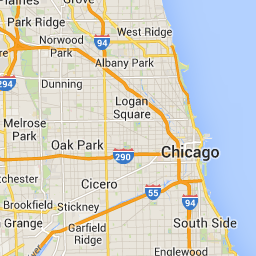 |
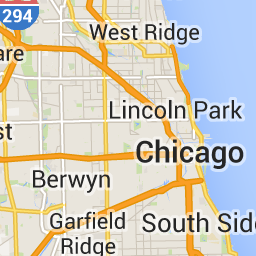 |
highDpi- Menentukan apakah akan menampilkan ubin resolusi tinggi. Jika faktor skala ditingkatkan,
highDpiakan digunakan untuk meningkatkan ukuran petak. Biasanya, meningkatkan faktor skala akan memperbesar petak yang dihasilkan menjadi gambar dengan ukuran yang sama, sehingga menurunkan kualitas. DenganhighDpi, ukuran yang dihasilkan juga ditingkatkan, sehingga kualitas tetap terjaga. DPI adalah singkatan dari Dots per Inch, dan DPI Tinggi berarti petak dirender menggunakan lebih banyak titik per inci daripada biasanya. Jikatrue, maka jumlah piksel dalam setiap dimensi x dan y dikalikan dengan faktor skala (yaitu , 2x atau 4x). Area cakupan kartu tetap tidak berubah. Parameter ini hanya berfungsi dengan nilaiscale2x atau 4x. Tindakan ini tidak berpengaruh pada petak skala 1x.
| Faktor Skala 1x | Faktor Skala DPI Tinggi 2x |
|---|---|
 |
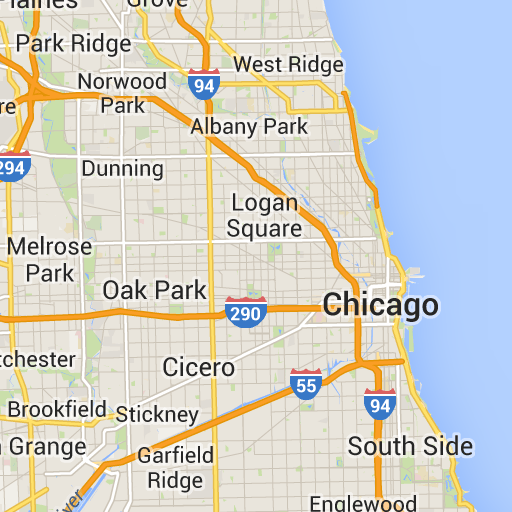 |
layerTypesArray nilai yang menentukan jenis lapisan yang ditambahkan ke peta. Nilai yang valid adalah:
layerRoadmap- Wajib diisi jika Anda menentukan
terrainsebagai jenis peta. Dapat juga ditumpangkan secara opsional pada jenis petasatellite. Tidak berpengaruh pada kartu peta jalan. layerStreetview- Menampilkan jalan dan lokasi yang mendukung Street View menggunakan garis biru di peta.
layerTraffic- Menampilkan kondisi lalu lintas saat ini.
stylesArray objek gaya JSON yang menentukan tampilan dan tingkat detail fitur peta seperti jalan, taman, dan area terbangun. Gaya visual digunakan untuk menyesuaikan peta dasar Google standar. Parameter
styleshanya valid jika jenis peta adalahroadmap. Untuk mengetahui sintaksis gaya lengkap, lihat Referensi Gaya.overlayNilai boolean yang menentukan apakah
layerTypesharus dirender sebagai overlay terpisah, atau digabungkan dengan gambar dasar. Jikatrue, peta dasar tidak ditampilkan. Jika Anda belum menentukanlayerTypes, nilai ini akan diabaikan.
Misalnya, meminta jenis peta satellite dengan lapisan layerRoadmap, dan
overlay disetel ke false akan menghasilkan ubin yang setara dengan jenis peta hybrid
yang digunakan di Maps JavaScript API (gambar kiri). Jenis peta dan lapisan yang sama dengan overlay yang ditetapkan ke true akan menghasilkan ubin transparan dengan overlay peta, yang diberi gaya dengan tepat untuk overlay di atas gambar satelit (gambar kanan).
overlay: salah (false) |
overlay: benar |
|---|---|
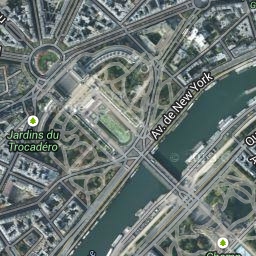 |
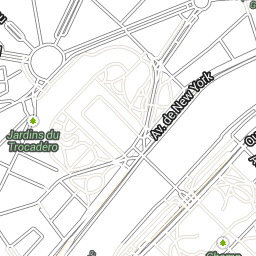 |
JSON berikut adalah contoh isi permintaan umum yang berisi kolom wajib dan opsional.
{
"mapType": "satellite",
"language": "en-US",
"region": "us",
"layerTypes": [ "layerRoadmap", "layerStreetview" ],
"overlay": true,
"scale": "scaleFactor1x",
"styles": [
{
"stylers": [
{ "hue": "#00ffe6" },
{ "saturation": -20 }
]
},{
"featureType": "road",
"elementType": "geometry",
"stylers": [
{ "lightness": 100 },
{ "visibility": "simplified" }
]
}
]
}
Contoh ini menyediakan overlay yang cocok untuk digabungkan dengan gambar satelit. Contoh ini berisi peta jalan dan overlay tampilan jalan. Peta yang dihasilkan dirender dengan nama dan data dalam bahasa Inggris, sebagaimana digunakan di Amerika Serikat.
Respons token sesi
JSON berikut adalah contoh isi respons.
{
"session": "IgAAAHGU9jnAU4KOAfwY3Bcd6eH_WxQsyocSBAdUnAr9pnvTTNXtF9c_27RBo94ytEXTDg",
"expiry": "1361828036",
"tileWidth": 256,
"tileHeight": 256,
"imageFormat": "png"
}
Daftar berikut berisi definisi kolom dalam isi respons.
session- Nilai token sesi yang harus Anda sertakan dalam semua permintaan Map Tiles API.
expiry- String yang berisi waktu (dalam detik sejak epoch) saat token berakhir masa berlakunya. Token sesi berlaku selama dua minggu sejak waktu pembuatannya, tetapi kebijakan ini dapat berubah tanpa pemberitahuan.
tileWidth- Lebar petak diukur dalam piksel.
tileHeight- Tinggi kartu diukur dalam piksel.
imageFormat- Format gambar, yang dapat berupa
pngataujpeg.

